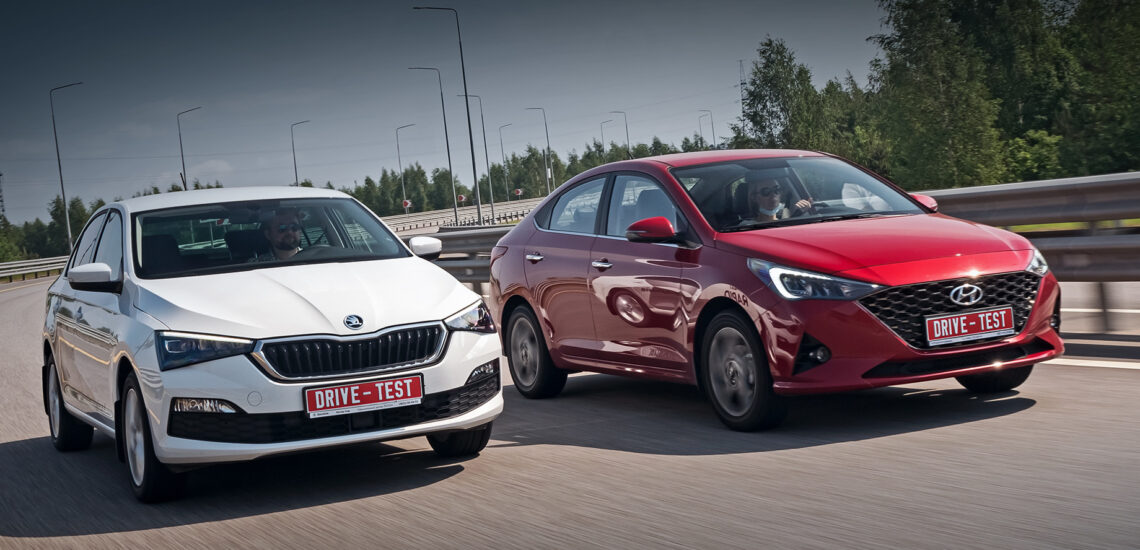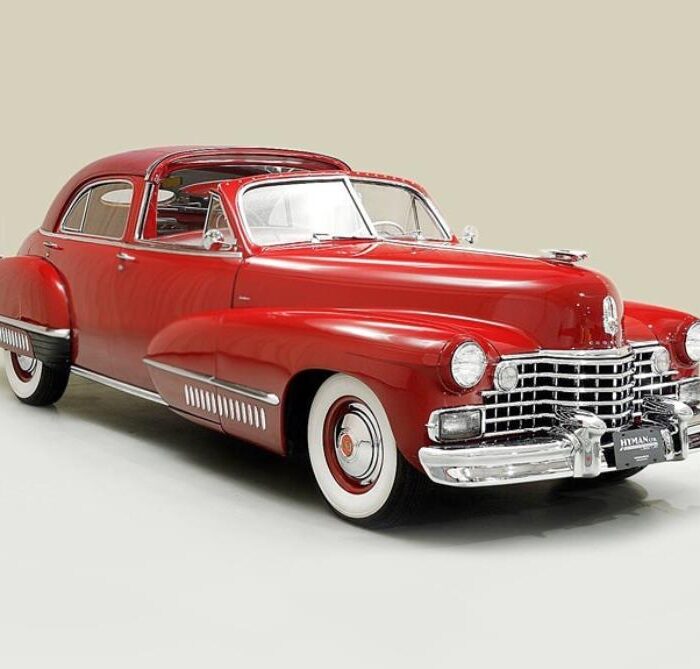Цього року мають оновитися всі бестселери сегмента B. Поки що в нашому розпорядженні седан Hyundai Solaris і ліфтбек Skoda Rapid. Перший дозволяє уявити, як зміниться соплатформенник Rio, а другий є попередником істотно уніфікованого нового Polo. Тестові автомобілі оснащені двигунами 1.6 без наддуву та шестиступінчастою автоматичною коробкою передач; ціни трохи відрізняються.
Ми відбираємо найскладніше обладнання, щоб оцінити максимум оновлень. У випадку Hyundai це спеціальна версія Prosafety; а Skoda — це версія Style із кількома опціями. Але в обох випадках значну частину додаткового обладнання можна придбати для середньої комплектації. Skoda має ширший вибір опцій і не обмежується безальтернативними пакетами, які пропонують корейці.
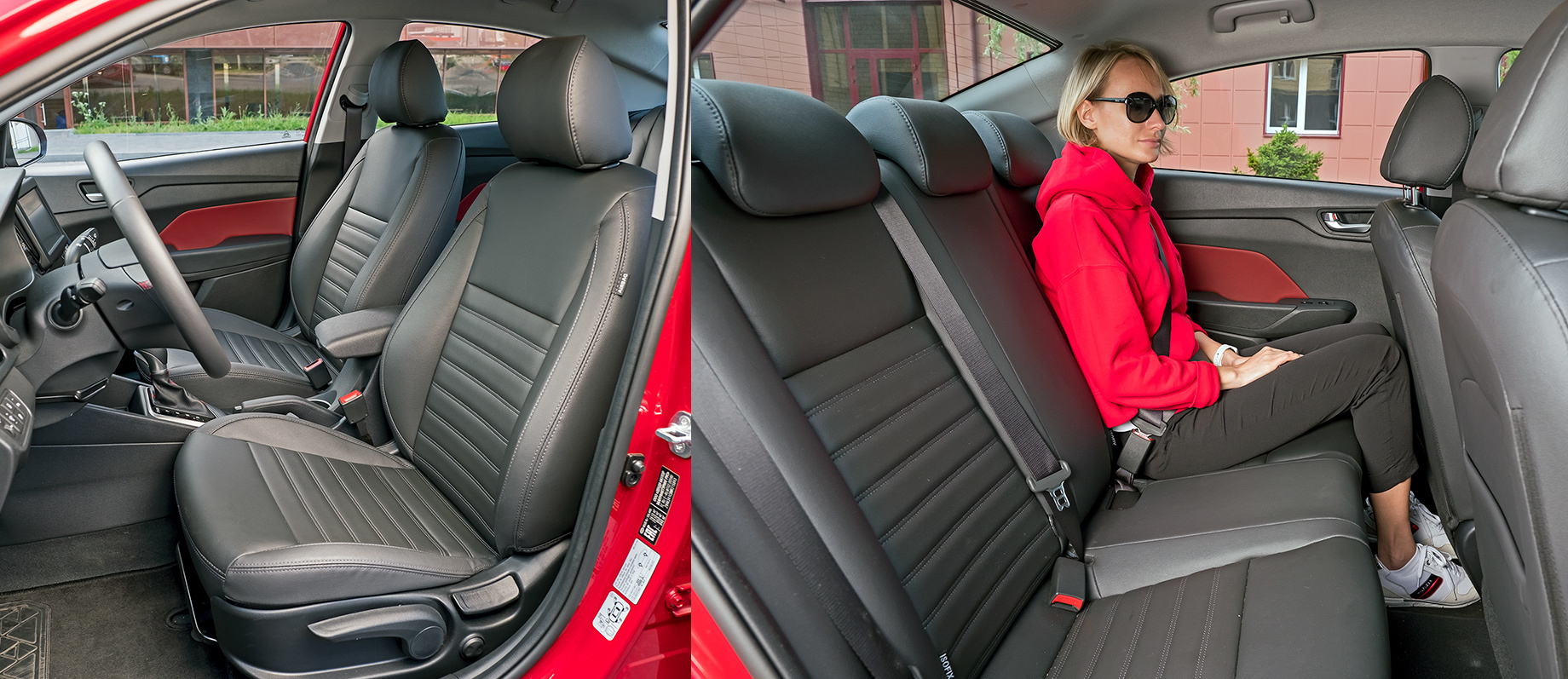
Обидві машини стали злішими і сучаснішими анфас, придбавши схожу «гостроту» світлодіодних фар — це базова комплектація для Skoda і опціональна для Hyundai. При погляді спереду Solaris виглядає цікавіше завдяки розвиненому пластику бампера і «3D» решітці радіатора, яка «проковтнула» номерний знак. Ззаду його важко відрізнити від дореформеної моделі, а ось Rapid з розширеними на двері багажника задніми ліхтарями став досить симпатичним. І знову у Шкоди діоди задньої оптики «в базі», а у корейця – поки тільки в версії Prosafety.
Solaris Prosafety збирається підкорювати покупців сидіннями зі шкірозамінника. Також з електромеханічними дзеркалами, а також медіасистемою з додатковими функціями та вбудованим навігатором: цього поки немає ні у Rapid, ні у інших конкурентів. Hyundai отримав дистанційний запуск двигуна з пам’яттю включення всіх обігрівачів. Однак запуск не підтверджується покажчиками повороту і доступний лише в топових версіях у поєднанні з безключовим доступом.
Перевагою Rapid є Front Assist, перша в бюджетному сегменті система контролю дистанції та автоматичного гальмування з радаром у нижній частині переднього бампера. Трохи «покататися» по машині, що їде вперед, і на дисплеї з’явиться попередження. Пізніше запропонують і електронну панель приладів. Але поки доводиться мучитися з погано читаними старовинними циферблатами. Асистент дальнього світла є ще однією опцією, унікальною для цього сегменту.
Салон Skoda виглядає багатше корейського, особливо в «топовому» варіанті, зі сріблястою вставкою навпроти переднього пасажира. З точки зору дизайну, до Rapid повернулося візуальне відчуття сучасності та якості салону. Хоча насправді скрізь жорсткий пластик, окрім підлокітників. Малюнок тканини на сидіннях милий. Але зручніше вони не стали, зберігаючи нерегульоване прогинання в поперековій області. Посадка не така полегшена: незважаючи на всі регулювання, кермо ближче до педалей, ніж у Hyundai. Так і було.
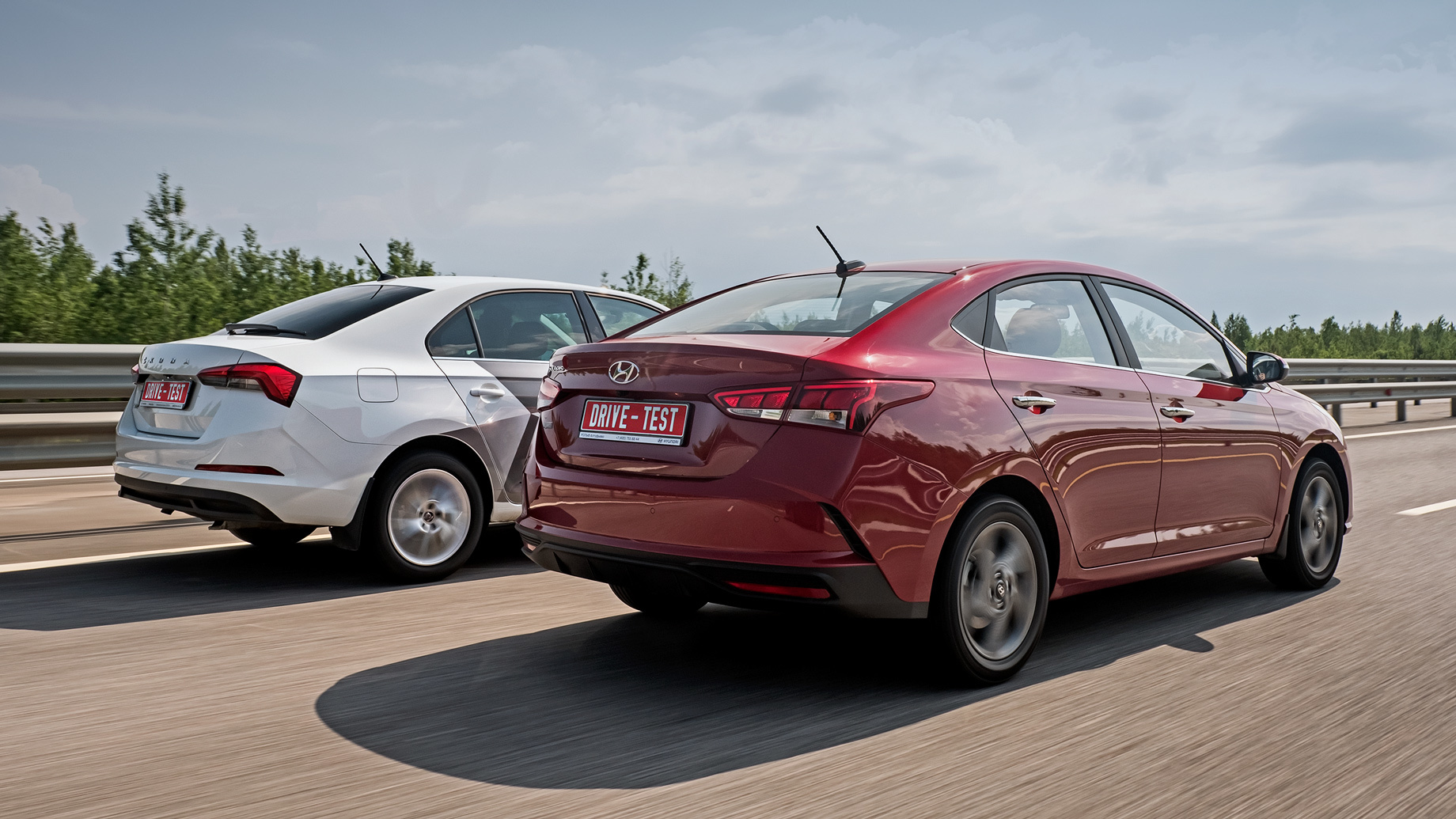
Сидіння Solaris більш жорсткі, плоскі та мають коротшу подушку. Зате поперековий упор з електрорегулюванням (вже в базовій версії!) менше навантажує спину в далекій дорозі. Завжди мокра спина, «завдяки» шкірозаміннику. Салон Hyundai теж став цікавішим. Стеля краще, ніж у Шкоди, але дефлектори з розсувною застібкою трохи пропускають повітря в положенні «заблоковано». Дорослий восьмидюймовий дисплей медіасистеми наживо стирчить з панелі не так нахабно, як на фото.
Проте опціональний медіакомплекс Skoda відрізняється кращою графікою, цікавішим дизайном і меншою затримкою відгуків на дотик. У Solaris вам потрібно сильніше натиснути на екран, щоб досягти реакції. А хвалений навігатор включається через раз — у відповідь на натискання іконки часто або нічого не відбувається, або вискакує повідомлення про помилку. Єдина претензія до мультимедіа Рапіда – нестабільне Bluetooth-з’єднання з телефоном.
Яка класна тривимірна музика і панелі управління борткомп’ютером на спицях нового керма Skoda, з барабанами, що обертаються і натискають! Я хотів сказати «гідно преміум», але при першому повороті мої пальці потрапили на дивний штапик в нижній частині двоспицевого керма, і з нього випала декоративна заглушка.. І все ж кількість приємних нюансів в Rapid трохи більше. Візьмемо, наприклад, заднє сидіння з повним підігрівом на тлі однієї подушки в Solaris або справний клімат-контроль на тлі галасливої корейської установки, яка різко змінює температуру потоків.
Наскільки містким і зручнішим є багажник Skoda, тепер знають навіть діти. Справа не тільки в об’ємі і набагато більш зручному доступі завдяки кузову типу ліфтбек. Ви можете замовити люк для довгоміру на Rapid. Під підлогою теж є якийсь органайзер, а не просто металевий, як у Hyundai. Плюс гачки, липучки для вантажу, розетка на 12 вольт.. Нагадаю, дві тестові машини коштують однаково.
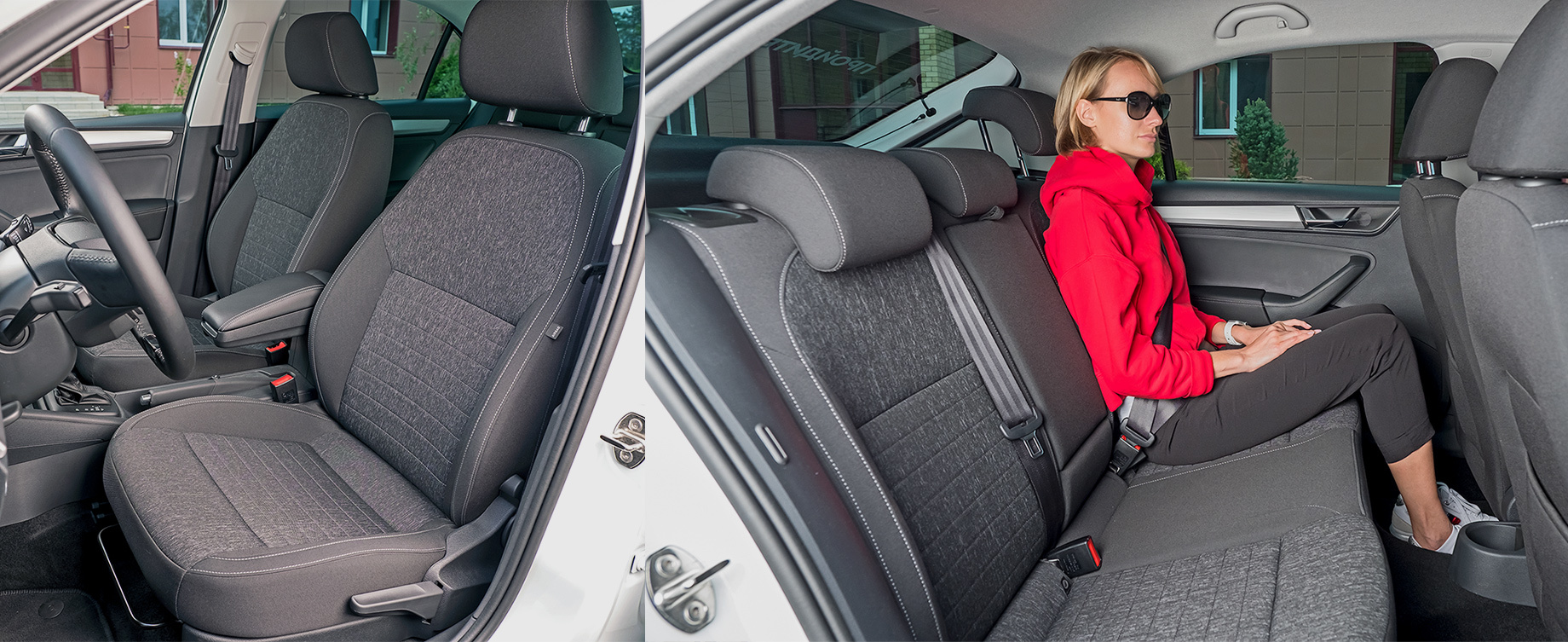
Задні сидіння Rapid також більш просторі. Для мене загадка, чому «Соляріс» такий популярний як таксі, адже сидіння тут відверто тісно: я впираюся і колінами, і головою «за собою» з ростом 6 футів 2. Життя можливе лише тоді, коли таксист штовхає праве сидіння вперед. У Skoda вже є додатковий простір для пари пальців на колінах, а стеля приблизно на дюйм вище. Rapid має підстаканники та центральний підлокітник ззаду, а Solaris — ні. У чеської машини в спинках сидінь дві кишені, а в корейської – лише одна. У жодного з них немає автоматичних задніх вікон.
Не чекайте новин про ходові характеристики: налаштування фактично не змінилися. Однак на наших сторінках раніше не зустрічалися «Соляріс» і «Рапід», тому я нагадаю вам основні особливості. З корейської сторони більш потужний двигун (123 к.с. проти 110), і ця різниця відчувається в розгоні «в підлогу». Skoda бере доплату за енергійний двигун 1.4 TSI з турбонаддувом (125 к.с.) з роботом DSG. Тут обидві АКПП шестиступінчасті, і обидві не молодці. При спокійній їзді це добре, але при нерівномірному темпі і Соляріс, і особливо Рапід смикаються при перемиканні передач вниз, супроводжуючи розгін ревом моторів. Перевагою Hyundai є чітке гальмування двигуном.
Однак цієї потужності достатньо, щоб безпечно підтримувати швидкість 87-93 миль/год, наприклад, на платній трасі М11, якою ми їхали. Їздити тут на Skoda приємніше: вона без проблем тримає пряму, логічно центруючи кермо. Solaris вимагає невеликих корекцій, ускладнених деякою «непрозорістю» рульового приводу в навколонульовій зоні. Хоча проблем ні з реакцією, ні з відповідями по черзі немає. Причому Hyundai цікавіше веде себе в екстремальному повороті, демонструючи мінімальну недостатню поворотність, характерну для Skoda.
Колеса обох автомобілів 16-дюймові, тоді як більшість бюджетників продаються на «п’ятнадцятих». На рівній дорозі «Соляріс» не залишає без уваги жодні дефекти дорожнього полотна, але заміську смугу долає гнучко, з хорошою енергоємністю. Шорсткий асфальт викликає більш відчутний високочастотний свербіж на кермі і педалях, ніж у Skoda. По трасі Rapid ходить трохи благородніше, з приємним відтінком гойдання на хвилях, але більше боїться розбитих доріг, сильніше трясе на ямах і стиках. А озвучування несправностей у Skoda більш грубе. Хоча, підсумовуючи все сказане, плавність ходу у цих машин приблизно на одному рівні.
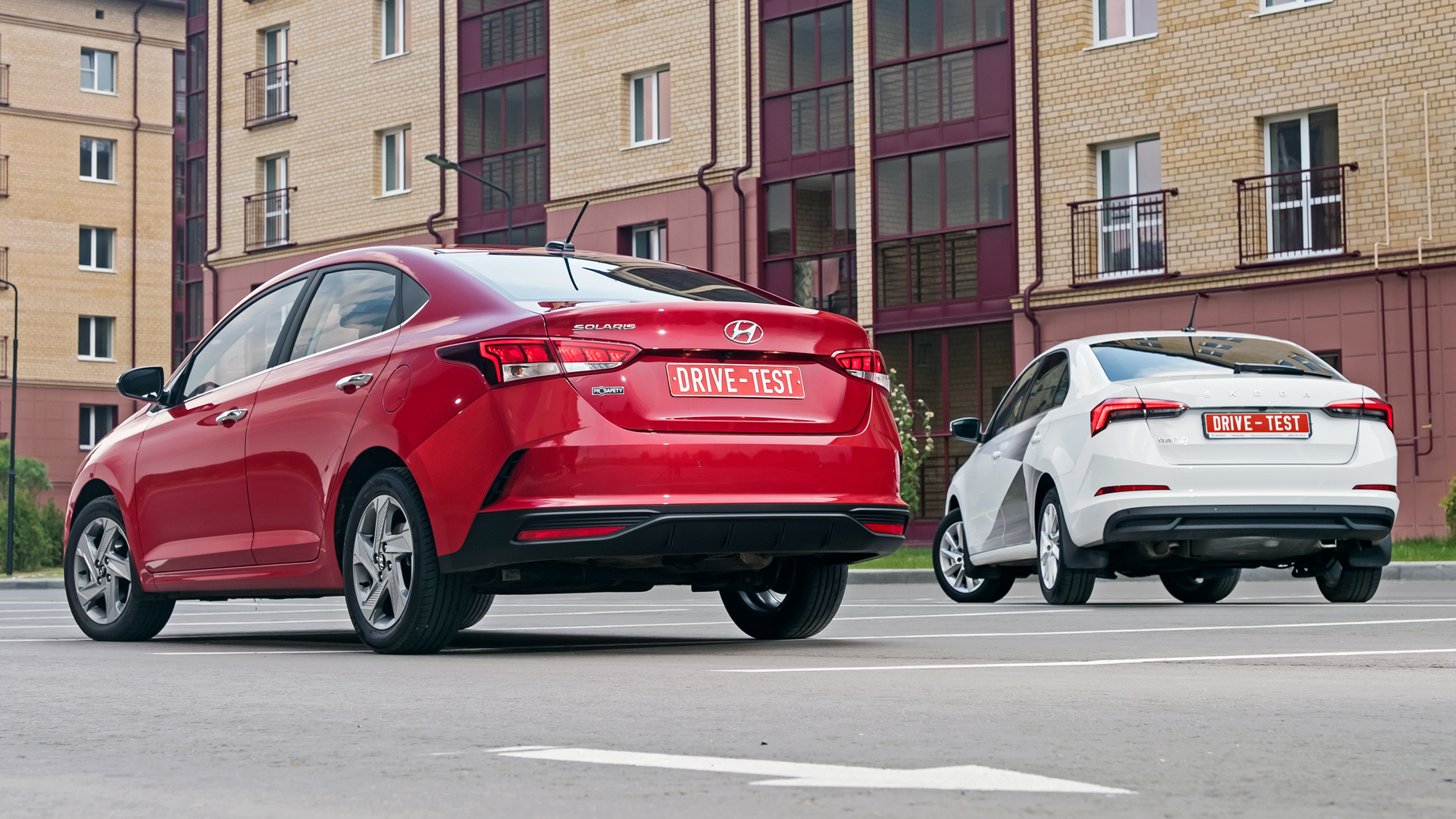
Але Соляріс більш шумний і вібронавантажений. Таке відчуття, що двигун працює на холостому ходу. У місті салон наповнений дзижчанням шин, і він домінує над іншими звуками, наприклад, ревом двигуна під час інтенсивного розгону, до 60-75 миль/год. Але тут аеродинаміка тихіше, тоді як у Skoda це починає проявлятися на схожих швидкостях. На шосе Rapid більше не має такої переваги в акустичному комфорті, як при повільній їзді.
Тим не менш, дизайнери можуть підкоригувати профіль передніх сидінь Шкоди, розширити маленькі дзеркала і розібратися з незмінним тунелем, на якому ні мобільний телефон, ні термочашку нормально не помістиш, і все буде цілком нормально. Загалом робота над помилками глибока. Оновлення Solaris зробило трохи неправильний крок, у кітч, як шкірозамінник. Давно пора щось робити з шумом, а шасі завжди було бадьорим. За співвідношенням ціна/якість Hyundai не виграє у Skoda. Принаймні, в цих дорогих версіях.
Це переклад. Оригінал можна прочитати тут: https://www.drive.ru/test-drive/hyundai/skoda/5ef4beefec05c49b2f00010a.html

Опубліковано Листопад 17, 2022 • 6хв на читання

